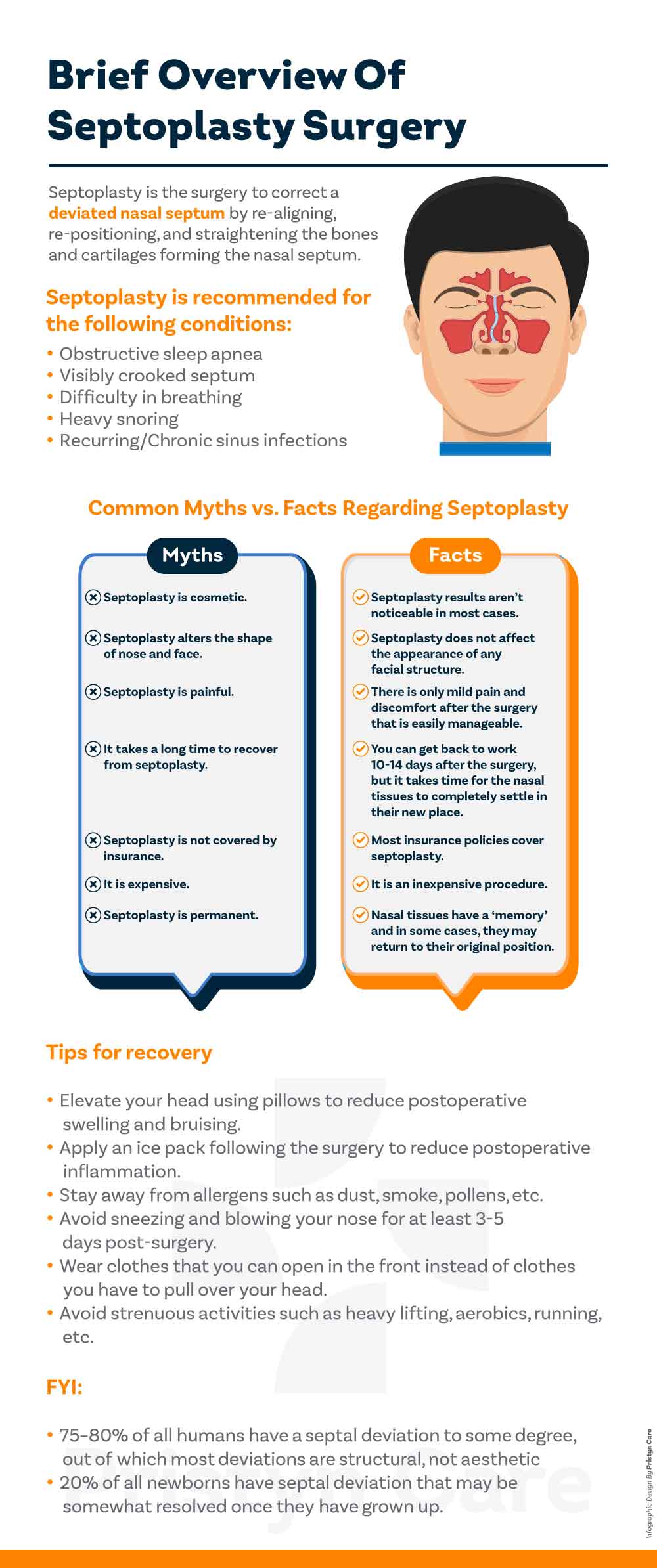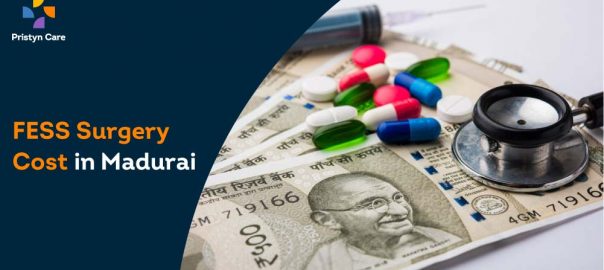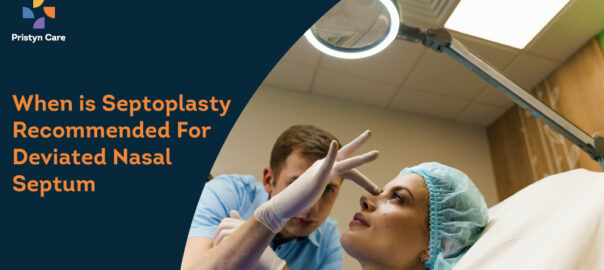![]() Views: 533
Views: 533
A Guide To Septoplasty
Dedicated Support at Every Step!
Our Doctors are available 24 hours a day, 7 days a week to help you!
Table of Contents
About Septoplasty
No Cost EMI, Hassle-free Insurance Approval
Why is septoplasty considered necessary?
A mildly crooked septum is very common, but if severe, it can lead to serious difficulties in breathing, including loud snoring, recurring sinus infections, etc. Often, depending on the patient’s symptoms, it can be combined with other surgeries such as turbinectomy, turbinoplasty, FESS surgery, rhinoplasty, etc.
Septoplasty is performed in the following cases:
- Repair deformed nasal septum which occurred due to an injury or birth defect
- Difficulty in breathing through the nose
- Mouth breathing
- Recurring sinus infections
- Increased epistaxis, i.e., nose bleeding
- Increased headaches due to sinus infections
Also read: Signs Of Deviated Nasal Septum And What To Do About It?
How can you prepare for septoplasty?
Before the surgery, the surgeon will evaluate your medical history and perform a physical examination to diagnose the extent of the deviation. Simultaneously, septoplasty is a functional surgery, so it will not improve your nose aesthetically. Therefore, you should discuss your expectations with your surgeon.
You should not take medicines like aspirin, ibuprofen, etc., before and after the surgery as they increase the risk of bleeding. If you are habitually taking any blood thinners, you need to stop those a few days before the surgery. During this period, you should only take medicines after approval from your doctor.
Smoking increases the risk of anesthetic complications, so if you smoke, you should stop 2-3 weeks before the surgery. Do not eat or drink anything following midnight on the day of the surgery.

What happens during septoplasty procedure?
Although it can be done under local anesthesia, septoplasty is normally performed under general anesthesia. It involves the straightening of the nasal septum by trimming, repositioning, and replacement of parts of the nasal septum. If there is severe deviation, spreader grafts may be needed to reinforce the cartilage position in their new position.
Once the correction is done, the incision is closed using absorbable sutures, and silicone splints are inserted to stabilize the nasal septum. Finally, absorbent bandages will be used to pack the nose and limit bleeding. After this, the patient is moved to a recovery room.
Typically, the procedure can be performed outpatient, but patients are usually hospitalized to ensure there are no complications. The entire procedure takes about 30-90 minutes, depending on the extent of correction needed.

What happens after septoplasty?
After the surgery, majority of the patients can return to work within a week, however, strenuous physical activities and sports have to be avoided until at least two weeks.
Generally, it takes about 3-6 months for the nasal tissues to settle into their new shape completely. Hence, it takes a little time for patients to notice an improvement in their breathing post-surgery.
You can follow the given tips to improve your recovery:
- Elevate your head while sleeping.
- Apply an ice pack following the surgery to reduce postoperative bruising.
- Stay away from allergens such as dust, smoke, pollens, etc.
- Don’t blow your nose for at least 3 days or till the incisions have closed.
- Wear shirts instead of T-shirts, sweatshirts, etc., i.e., clothes that you have to pull over your head.
- Avoid strenuous activities such as heavy lifting, aerobics, running, etc., for up to 5 weeks to avoid nosebleeds.
Also Read: First-Hand Experience Of A Septoplasty Patient At Pristyn Care
Which surgeries are often performed in conjunction with septoplasty?
- Turbinoplasty: It is a surgery that is performed to reduce the size of nasal turbinates, if needed, to clear the airway and make breathing easier.
- FESS surgery: FESS is performed to drain the paranasal sinuses and remove nasal obstructions and restore normal airway if the patient has chronic sinusitis.
- Uvulectomy: Uvulectomy is the surgical removal of all or part of the uvula is removed to open the airway and reduce snoring and treat obstructive sleep apnea (OSA).
- Tonsillectomy: If the patient has recurring tonsillitis or large tonsils blocking the airways, septoplasty may be accompanied by tonsillectomy.
- Pharyngoplasty: Pharyngoplasty is performed to reduce the space behind the palate to preserve the air from escaping while speaking. It is also performed for snoring.
- Adenoidectomy: Septoplasty is accompanied by adenoidectomy if the patient has adenoiditis or large tonsils blocking the airway.
- Rhinoplasty: If the patient wants aesthetic correction of the nose size, shape, and position, the procedure may be combined with a rhinoplasty (called rhinoseptoplasty).
What are the risks of septoplasty?
Some common risks associated with septoplasty are:
- Failure to resolve the symptoms, i.e., continued nasal obstruction
- Hemorrhage
- Scarring
- CSF leakage
- Change in the shape of the nose
- Septal perforation
- Decreased sense of smell
- Alteration of the voice quality
- Hematoma formation
- Temporary numbness of the gums, teeth, or nose.
- Anesthesia-related complications
What are the benefits of septoplasty?
Septoplasty can improve the quality of life by providing the following benefits:
- Improved breathing
- Better sleep quality and relief from sleep apnea
- Relief from recurring sinusitis
- Improved senses
- Cures snoring
Septoplasty vs. Rhinoplasty
Septoplasty is a functional surgery that is performed to correct the structural defects of the nasal septum to clear the airway and improve breathing easier.
Rhinoplasty, or nose job, is a surgery that enhances the outer appearance of the nose. During the procedure, the tip, bridge, and rotation of the nose may be changed to reshape a ‘crooked’ nose to a better position and aesthetic appearance.
Both the procedures can be combined and called rhinoseptoplasty to provide improved ‘form and function’ to the patient.
Which doctor performs a septoplasty procedure?
Septoplasty is performed by an expert ENT surgeon. If you are looking for an ENT specialist near you, you can consult Pristyn Care. Pristyn Care is a leading surgery provider associated with expert ENT doctors all over the country.










